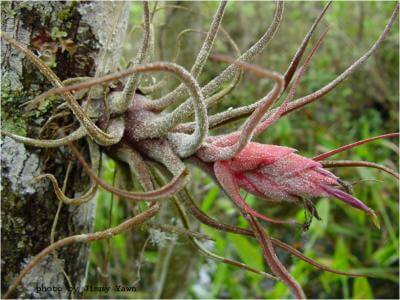
NOTE: this pest is not known to spread in or on firewood. It is included in the Gallery of Pests for general information purposes only.
The Mexican bromeliad weevil (Metamasius callizona) is a bromeliad-eating weevil that is native to southern Mexico and Guatemala (Frank and Thomas 1994; Frank and Cave 2005). The weevil immigrated to Florida on a shipment of ornamental bromeliads from Mexico. The weevil was detected in a nursery in Broward County, Florida in 1989. An attempt was made to eradicate the weevil but it was too late because the weevil had already become established on native bromeliad species. Since 1989, the weevil has spread to nearly fill its new range (Frank 1996). By 2009 it was documented in 22 Florida counties, the northernmost being Volusia.
The Mexican bromeliad weevil attacks medium and large bromeliads (Salas and Frank 2001; Cooper 2006). The larvae mine the meristematic tissue of the bromeliad, killing the plant. Florida has 16 native species of bromeliads and 12 of them are susceptible to attack by the weevil (Frank and Cave 2005). The species under threat include Tillandsia utriculata, T. fasciculata, T. flexuosa, T. simulata, T. variabilis, T. balbisiana, T. paucifolia, T. pruinosa, Catopsis berteroniana, C. floribunda, C. nutans, and Guzmania monostachia.
Even before the Mexican bromeliad weevil began having an impact, 8 native bromeliad species were listed as threatened or endangered (Frank and Cave 2005). Two more species (T. utriculata and T. fasciculata) were listed as endangered because of the damage caused by the weevil. Weevil attacks have caused the destruction of local populations of susceptible bromeliads in several of Florida’s protected areas, including the Enchanted Forest Sanctuary, St. Sebastian Preserve State Park, Myakka River State Park, and Lake Rogers State Park (Cave pers. comm. 2009).
Bromeliads are important to Florida’s ecosystems and are crucial to the survival of other species (Frank 1983; Frank and Fish 2008). Up to 15 invertebrate species depend on bromeliads for habitat (they live in the water collected at the bases of the leaves). With the loss of the bromeliads, these species would also be lost.
The only way to control the weevil is by using classical biological control (Frank and Cave 2005). Classical biological control is the use of a natural enemy to reduce a pest population and thereafter maintain the pest population at low, non-destructive levels. In 1991 a biological control program was initiated to control the Mexican bromeliad weevil in Florida and, beginning in 1992, searches were made for a natural enemy in and/or near the weevil’s homeland (Frank and Cave 2005). In 1993 a potential biological control agent, Lixadmontia franki, was discovered in Honduras on a related species of bromeliad-eating weevil (M. quadrilineatus; Cave 1997; Wood and Cave 2006). Lixadmontia franki is a tachinid fly that parasitizes bromeliad-eating weevils and, in the laboratory, was shown to parasitize the Mexican bromeliad weevil (Frank and Cave 2005). In 2007, permission was received to release the fly in natural areas to attempt to control the weevil. Since then, more than 3,100 L. franki flies have been released. Post-release monitoring was conducted to determine if the fly can survive and reproduce in the wild and if the fly becomes established. The fly can survive and reproduce in the wild but there is (as yet) no evidence that the fly has become established or that it is having any affect on weevil populations (Cave 2008).
USFS scientists and managers developed a conservation priority-setting framework for forest tree species at risk from pest & pathogens and other threats. The Project CAPTURE (Conservation Assessment and Prioritization of Forest Trees Under Risk of Extirpation) uses FIA data and expert opinion to group tree species under threat by non-native pests into vulnerability classes and specify appropriate management and conservation strategies. The scientists prioritized 419 tree species native to the North American continent. The analysis identified 15 taxonomic groups requiring the most immediate conservation intervention because of the tree species’ exposure to an extrinsic threat, their sensitivity to the threat, and their ability to adapt to it. Each of these 15 most vulnerable species, and several additional species, should be the focus of both a comprehensive gene conservation program and a genetic resistance screening and development effort. Mexican bromeliad weevil is not known to be a threat to any of these 15 most vulnerable species.
Sources
Cave RD. 1997. Admontia sp., a potential biological control agent of Metamasius callizona. J Brom Soc. 47:244-249.
Cave RD. 2008. Biological control of the Mexican bromeliad weevil. Biocontrol News and Information 29(1):1N-2N.
Cooper TM. 2006. Ecological and demographic trends and patterns of Metamasius callizona (Chevrolat), an invasive bromeliad-eating weevil, and Florida’s native bromeliads [Master’s thesis]. [Gainesville (FL)]: University of Florida. 69 p.
Frank JH. 1983. Bromeliad phytotelmata and their biota, especially mosquitoes. In: Frank JH, Lounibos LP, editors. Phytotelmata: terrestrial plants as hosts for aquatic insect communities. Medford (NJ): Plexus. p. 101-128.
Frank JH. 1996. Bromeliad biota: history of Metamasius callizona Florida [online]. Gainesville (FL): University of Florida [cited 2010 Feb 1]. Available from https://www.entnemdept.ufl.edu/frank/bromeliadbiota/wvbrom6.htm
Frank JH, Cave RD. 2005. Metamasius callizona is destroying Florida’s native bromeliads. In: Hoddle MS, editor. USDA Forest Service Publication FHTET-2005-08. Vol 1. Second International Symposium on Biological
Control of Arthropods; 2005 Sep 12-16; Davos, Switzerland. Washington D.C.: USDA Forest Service. p. 91-101.
Frank JH, Fish D. 2008. Potential biodiversity loss in Florida bromeliad phytotelmata due to Metamasius callizona (Coleoptera: Dryophthoridae), an invasive species. Florida Entomol. 91(1):1-8.
Frank JH, Thomas MC. 1994. Metamasius callizona (Chevrolat) (Coleoptera:Curculionidae), an immigrant pest, destroys bromeliads in Florida. Can Entomol.126(1):673-682.
Potter, K.M., Escanferla, M.E., Jetton, R.M., Man, G., Crane, B.S., Prioritizing the conservation needs of US tree spp: Evaluating vulnerability to forest insect and disease threats, Global Ecology and Conservation (2019), doi: https://doi.org/10.1016/
Salas J, Frank JH. 2001. Development of Metamasius callizona (Coleoptera:Curculionidae) on pineapple stems. Florida Entomol. 84(1):123-126.
Wood DM, Cave RD. 2006. Description of a new genus and species of weevil parasitoid from Honduras (Diptera: Tachinidae). Florida Entomol. 89(2):239-24.



